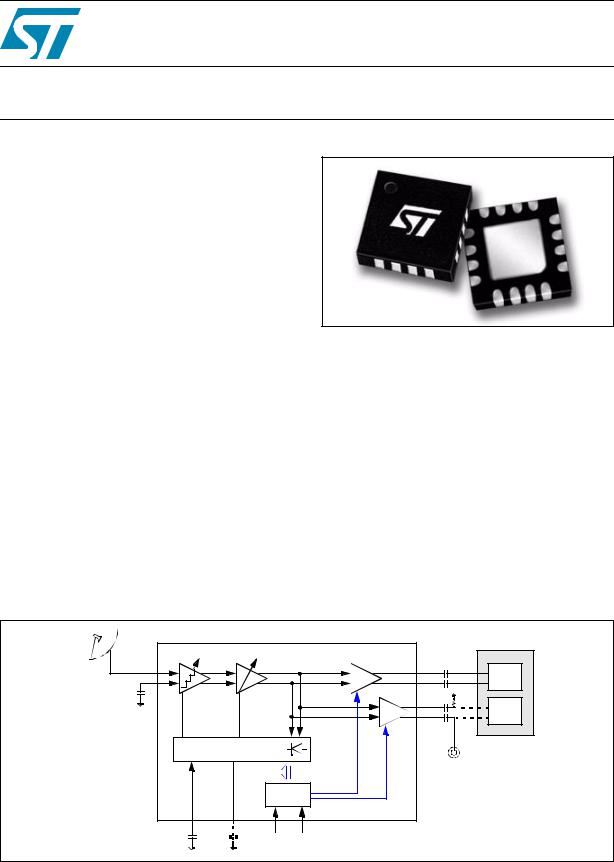ST STVVGLNA User Manual

STVVGLNA
General-purpose, variable-gain, low-noise, RF amplifier for broadcast receiver applications
Data brief
Features
■75-Ω single-ended input impedance
■75-Ω single-ended or 150-Ω differential output impedance
■Dual differential or single-ended outputs
■Single 3.3-V DC supply
■Input frequency range 50 to 2150 MHz
■Fully integrated RF AGC with power monitoring
■Low external component count
■Low power consumption (145 mW typical)
■Temperature range -35 °C to 85 °C
■Compatible with 5-V and 3.3-V I2C bus
■I2C bus control (option)
■Four selectable I2C addresses C8,CA,CC,CE
Package
■VFQFPN-16L 3x3x0.85 mm3 with exposed pad down (EPD)
■Environmentally friendly packaging, RoHS (2002/95/EC) compliant.
Applications
■Satellite set-top boxes
■SMATV RF accessories
■LNBs
■DVB-T active indoor antennas
Figure 1. STVVGLNA block diagram
Description
The STVVGLNA is a general-purpose, low-noise amplifier with a gain range of -17 dB to +15 dB. Its gain is regulated either autonomously by an integrated AGC loop or by software control.
It can be used, for example, as an input amplifier for a satellite set-top box.
|
|
|
STVVGLNA |
|
|
|
TV1 |
|
|
|
tuner |
|
|
|
DVR |
|
|
|
tuner |
|
AGC loop |
F |
|
|
|
|
|
|
|
|
I2C |
VAGCI |
VAGCO |
SCL |
SDA |
June 2011 |
Doc ID 018892 Rev 1 |
1/4 |
For further information contact your local STMicroelectronics sales office. |
www.st.com |
|

Introduction |
STVVGLNA |
|
|
1 Introduction
The STVVGLNA is a front-stage amplifier designed for set-top boxes. It has high input power dynamic range to allow the optimization of sensitivity and linearity requirements.
The STVVGLNA has several operating modes suitable for different signal conditions:
●automatic wide-band mode, internal AGC (the default mode)
●semi-automatic wide-band mode, internal AGC
●fixed gain mode, no AGC
●variable gain with external AGC (driven by demodulator, for example)
The mode of operation is programmable via the I2C bus.
The STVVGLNA also provides a RF-signal-level indication which may be interrogated via the I2C bus. This is useful for installation and status information.
At power-on, the STVVGLNA starts in automatic and autonomous AGC mode so that it can operate in satellite set-top boxes, LNBs or SMATV accessories without any software assistance.
Features
Active amplitude compensation and balanced/differential operation.
Four AGC/Gain programmable operating modes.
Programmable via I2C bus.
Wide range of input frequencies.
Low component count plus tiny package with exposed pad.
Pre programmed automatic wide-band internal AGC mode.
Benefits
Simplified RF layout and increased robustness to interference.
Flexible AGC strategy.
The device can be µP controlled.
Applications range from satellite receivers down to VHF antenna amplifiers.
Small BOM and minimal use of PCB area.
No micro processor is required if the STVVGLNA is to be used in default mode.
2/4 |
Doc ID 018892 Rev 1 |
